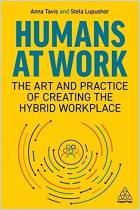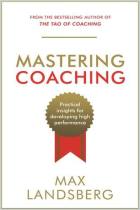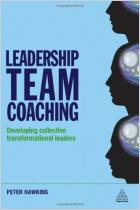Melden Sie sich bei getAbstract an, um die Zusammenfassung zu erhalten.

Melden Sie sich bei getAbstract an, um die Zusammenfassung zu erhalten.
Anna Tavis and Woody Woodward
The Digital Coaching Revolution
How to Support Employee Development with Coaching Tech
Kogan Page, 2024
Was ist drin?
Gain a comprehensive account of digital coaching — where it started, how it works, and where it’s headed.
Recommendation
Professional coaching has long been a human-centric domain, but that’s changing as coaches turn to technology to augment their services and coaching platforms embrace the potential of data analysis and digital delivery. In this comprehensive overview of the digital coaching field, coaches Anna Tavis and Woody Woodward chart the rise of the coaching industry from its roots in ancient Greece to today’s digital revolution. Tavis and Woodward explore the ways digital coaching — in corporate environments, sports, health care, and beyond — is redefining how people learn and grow.
Take-Aways
- Coaching can help individuals and organizations maximize their potential.
- Coaching has ancient roots but was not professionalized until the late 20th century.
- Digital coaching platforms are maturing toward full autonomy.
- Digital coaches and coaching platforms use data to deliver tailored interventions.
- In sports, coaches have learned the limitations of data and technology.
- Holistic coaching can improve both individuals’ well-being and business productivity.
- As AI and chatbots continue developing, coaches must re-imagine their role.
- Digital coaching tools can help improve diversity-related outcomes.
- Credentialing is becoming more critical as coaching education moves from private companies to universities.
Summary
Coaching can help individuals and organizations maximize their potential.
The International Coaching Federation (ICF), the European Mentoring and Coaching Council (EMCC), and other major coaching associations define coaching as a collaborative process that inspires individuals and organizations to maximize their potential. Coaches help their coachees achieve affective, cognitive, skill-based, and results-based growth — that is, changes in how they feel, how they think, what they can do, and the goals they can achieve.
“A good coach will make his players see what they can be rather than what they are.” (Football coach Ara Parseghian)
Typically, these four outcomes unfold over an extended period because coaching is a process, not a quick fix. The coaching process includes assessing a client’s initial needs, agreeing to a set schedule, writing a contract, conducting the coaching sessions, measuring outcomes, and providing feedback. Although academic research on coaching is still in its infancy, a meta-analysis of scientific studies suggests it improves work satisfaction and well-being more than training.
Coaching has ancient roots but was not professionalized until the late 20th century.
Professional coaching has its origins in Socratic questioning, an ancient philosophical technique that uses open-ended questions and active listening to bring about self-awareness and a sense of responsibility. Influences from sports, psychology, and the management consulting world have shaped professional coaching, providing it with goal-setting theories, evidence-based coaching approaches, and a focus on developing leaders and organizations.
“The coaching profession has transitioned from a cottage industry to a recognized profession to what is now an emerging industry led by multi-billion-dollar private corporations.”
Coaching first became professionalized in the 1970s and 1980s, but services were confined to top executives at major companies. During the 2010s, the growing use of apps and other technologies gave rise to digital coaching. Although digital coaches follow the same protocols as traditional coaches, they rely on technology to enhance their coaching practice.
Digital coaching companies are making coaching services affordable to mid-sized companies via digital coaching platforms, which use machine learning to match coaches and coachees, offer group chats and Google Docs to help coaches and coachees stay in touch remotely, and provide dashboard tools for performance tracking. Specialized tools for schedule management and data collection allow coachees to take greater ownership of their own learning processes.
Digital coaching expanded during the pandemic, as overwhelmed employees struggled with balancing their personal and professional lives in an era of remote work. Today, many key players in the digital coaching space position themselves as coaching and development providers offering customized learning. As coaching services become more scalable, effective and standardized, the multi-billion dollar coaching industry will likely continue to grow and disrupt the $360 billion L&D industry.
Digital coaching platforms are maturing toward full autonomy.
Digital coaching has unfolded in four distinct phases over the past decade:
- Emergence — BetterUp, EZRA, and other digital coaching platforms emerged in the pre-pandemic era to provide digital coaching services to workers at Google, Microsoft, and other early adopters.
- Expansion — Coaches’ use of digital tools expanded from 24% pre-pandemic to 87% during COVID-19 as coaches helped Hilton, CVS, and other companies tackle remote work challenges such as employee mental health and learning and development.
- Maturation — Digital coaching platforms matured into strategic partners working with clients to offer specialized services to align individual success with broader organizational goals.For example, EZRA introduced “Focus by EZRA” — short programs concentrated on a single theme — alongside personalized one-on-one coaching sessions with AI-supported behavioral nudges to guide people to act in specific ways.
- Optimization — Digital coaching platforms are in the process of developing autonomous systems that integrate AI, chatbots, and behavioral nudges. Already, Lever’s Australian Coach M offers an automated “coachbot” that requires little human involvement. Studies show that only 2% of employees using Coach M wanted human intervention in their coaching. The ultimate goal of this stage is to embed digital coaching deeply within organizational frameworks, utilizing AI to foster a culture of universal coaching access.
Digital coaches and coaching platforms use data to deliver tailored interventions.
Despite initial resistance, coaches now embrace data and technology to create more personalized, scalable, and accessible approaches for their clients. Data also allows digital coaching providers to collect empirical evidence demonstrating the value of coaching interventions. In 2023, CoachHub released its ROI Calculator to demonstrate its value. The calculator uses the number of coaching participants, their average salaries, employee turnover rate, annual company revenue, and the total number of employees within an organization to measure the effect of its coaching offerings on business performance and health.
“A coach with a bot will win over a coach without a bot.”
In addition to proving their value, digital coaching platforms also gather data to guide the overall direction of their coaching services. Increasingly, they’re experimenting with sentiment analysis (analyzing language to understand emotions and motivations), biometrics (using wearables to measure attention spans and stress levels), and other tools to inform evaluations of the effectiveness of interventions.
In sports, coaches have learned the limitations of data and technology.
Sports coaches have long used technology and data to enhance player performance, reduce instances of injury, and boost athletes’ mental health.
“Technology…cannot replace the depth of mentorship and the emotional bonds that develop between a coach and their client.”
However, these coaches have learned the downsides of becoming too dependent on digital tools, including the fact that relying too much on technology to track performance limits the important mentorship role coaches play in an athlete’s life. A focus on monitoring data over training can also lead to analysis paralysis and sub-optimal decision-making. Given these limitations, coaches must balance the use of data with relational interactions to drive individual and team performance.
Holistic coaching can improve both individuals’ well-being and business productivity.
Rising rates of pessimism, anxiety, and depression among workers reduce workplace performance and engagement. To combat these ills, organizations need to take a holistic approach to their employees’ growth. Digital health and well-being platforms, with their emphasis on “coaching the whole person,” are demonstrating the benefits of an integrated approach. As digital health services and organizational coaching merge, their combined efforts promise to create a more robust and productive workforce.
“Employees thrive when their well-being is prioritized, leading to increased engagement, productivity, and satisfaction.”
BetterUp, EZRA and CoachHub, for example, all offer coaching services that cover physical health, mental health, work-life balance, and personal development, understanding that prioritizing employee well-being leads to more engaged employees and productive companies. The BetterUp Care platform, in particular, matches people with certified coaches for personalized sessions, including, for example, advice on sleep and nutrition and tips on stress management. Personalized feedback assists employees in managing their health.
As AI and chatbots continue developing, coaches must re-imagine their role.
Powerful AI tools can recommend targeted learning resources to keep individuals on track between coaching sessions. AI-driven tools can also improve and streamline feedback. The video platform Ovida, for example, captures text, audio and video from coaching sessions and uses it to write summaries, highlight key points, and suggest data-backed areas of concern. Automated transcription services such as Otter.ai and Riverside can enhance the capabilities of existing platforms. In addition to these AI-driven tools, coachbots trained on how to help people set and attain goals can interact with clients to support their coaching goals.
“All of the serious players in the coaching space…have developed and deployed data analytics and chatbot technology driven by commercial AI tools.”
Integrating AI and chatbots into digital coaching platforms makes personalized learning accessible to a broader audience.That being said, successful coaching remains a very human endeavor. The challenge moving forward is determining the proper use of AI chatbots. As more traditional coaching tasks get automated, the role of professional coaching will need to be re-imagined.
Digital coaching tools can help improve diversity-related outcomes.
Digital coaching tools can help companies reach their DEIB (Diversity, Equity, Inclusion, and Belonging) goals. These tools support employees in internalizing DEIB values more deeply and in seeing its goals as attainable. Digital coaching tools can be scaled and personalized, applying equally well to the upper management employees determining an organization’s overall DEIB strategies, and to junior employees collaborating with team members.
“Through coaching, individuals can confront their biases, recognize their privilege, and develop a deeper sense of empathy.”
BetterUp focuses on the belonging part of DEIB, a pivotal factor in employee retention. BetterUp ensures that all employees who use their service have access to a coach. Through coaching, coaching circles, and workshops, people can explore diverse topics, such as how to deliver difficult feedback or recognize microaggressions. For leaders, BetterUp offers analytics to track, for example, the prevalence of inclusive behaviors and the sense of belonging among employees.
Credentialing is becoming more critical as coaching education moves from private companies to universities.
Worldwide, the number of coaches grew 54% between 2019 and 2022, yet the industry remains largely unregulated. This makes it challenging to ensure coaches have appropriate education, training, and credentials.That being said, professional coaching associations offer widely recognized credentials based on their own education and training standards. Although these standards vary somewhat, there’s overlap in core competencies.
“Education and training programs have…struggled to keep up with the increasing sophistication of the coaching profession, particularly when it comes to digital technology and AI.”
Universities are stepping up their coaching education opportunities as coaching becomes more professionalized. Institutions such as the Henley Business School in the UK, the University of Sydney in Australia, and New York University in the United States now offer graduate degree programs in coaching. These institutions will play critical roles in advancing research in coaching technology while training a new generation of coach practitioners.
About the Authors
Anna Tavis is clinical professor and chair of the Human Capital Management Department at NYU’s School of Professional Studies. Previously, she served as head of Motorola’s EMEA OD function based in London, Nokia’s global head of talent management based in Helsinki, United Technologies Corporation’s chief learning officer, and global head of talent and organizational development at AIG Investments. Michael “Woody” Woodward is an organizational psychologist and a CEC-certified executive coach. He serves on the Institute for Management Studies faculty, where he has trained managers from BOSE, Verizon, and the NBA. Woodward is the author of the Amazon top-selling book The YOU Plan.
This document is restricted to personal use only.


























Comment on this summary
- He gives strategies for overcoming these challenges and making sure that digital training remains powerful and ethical.